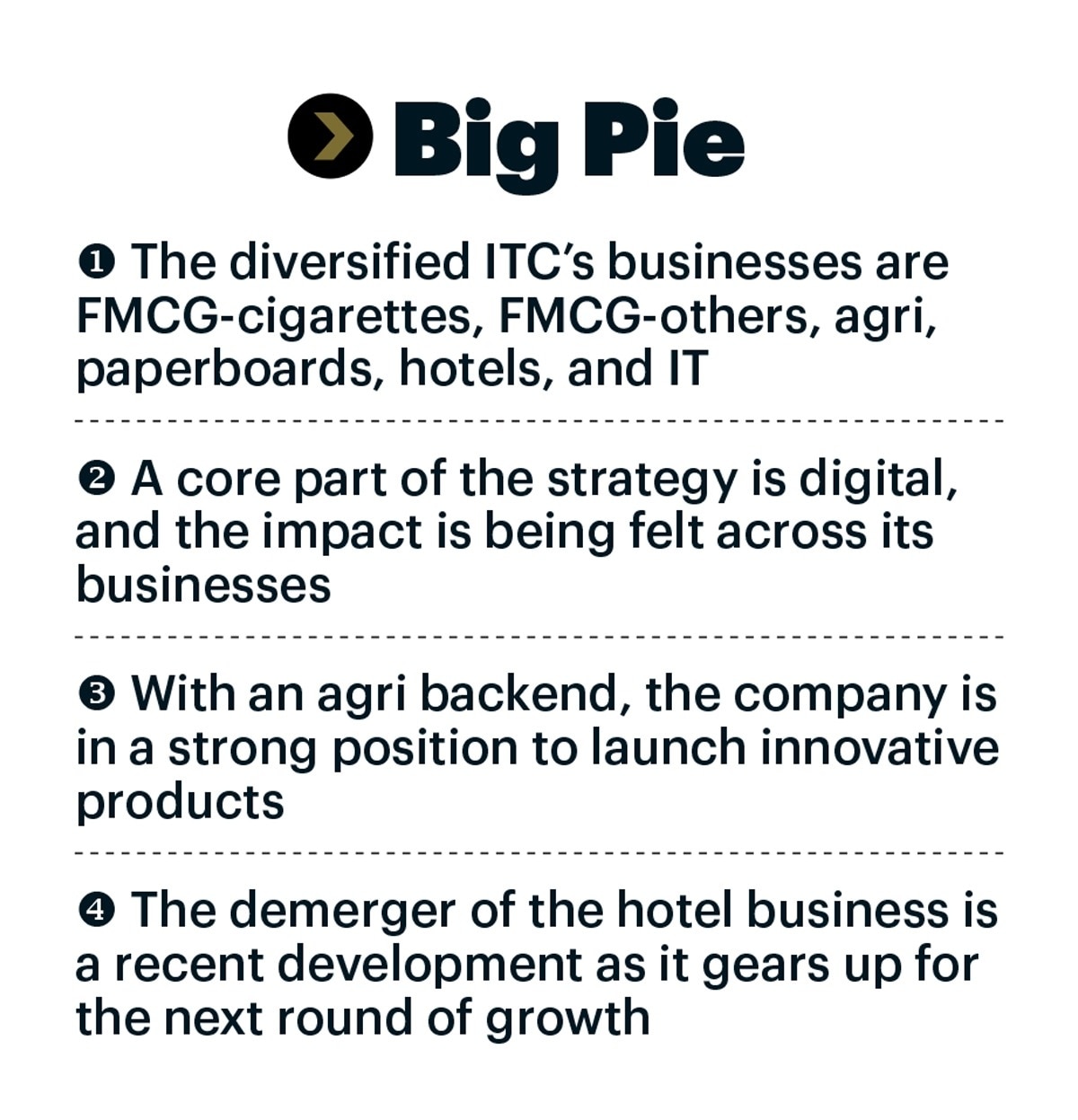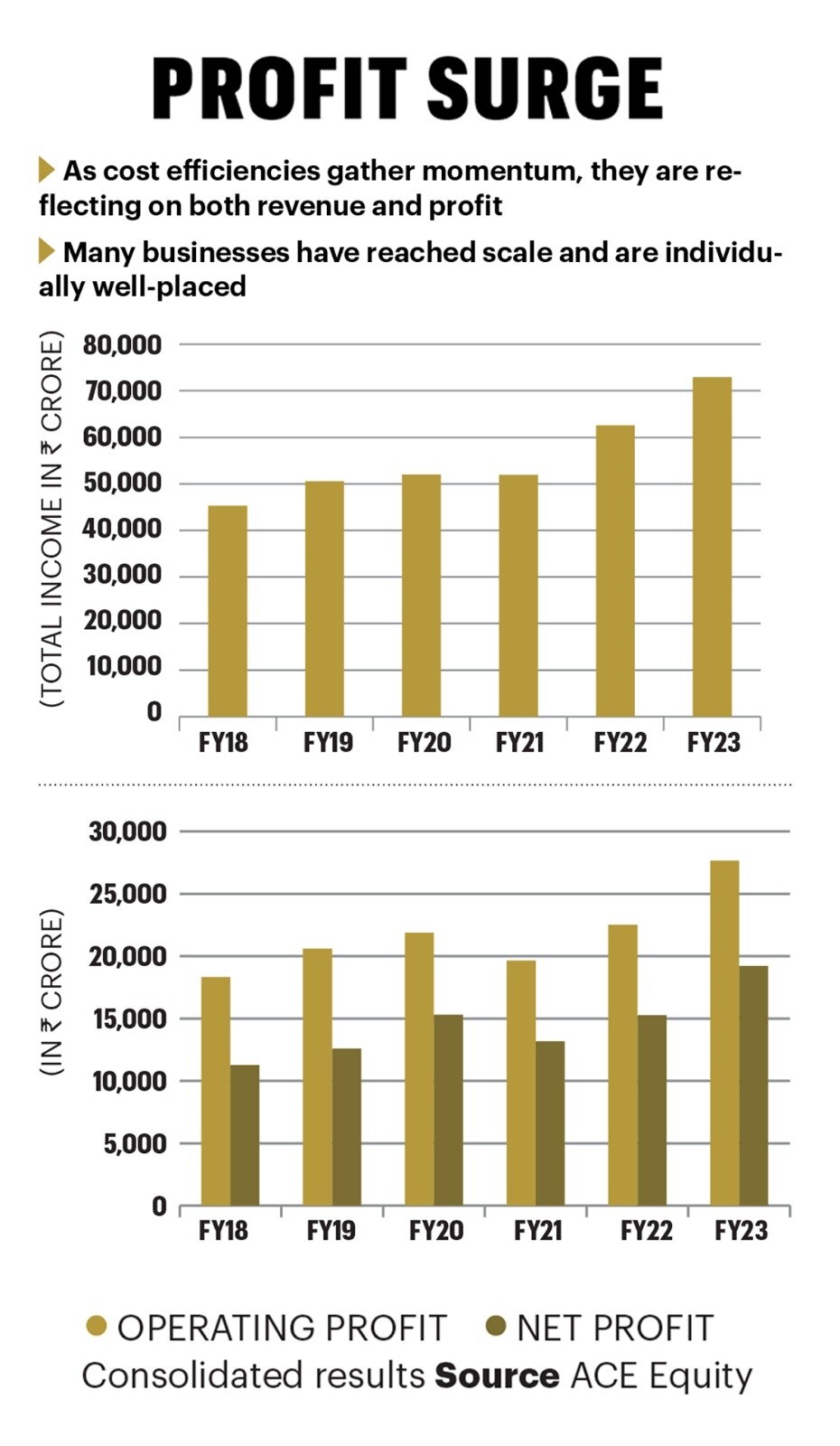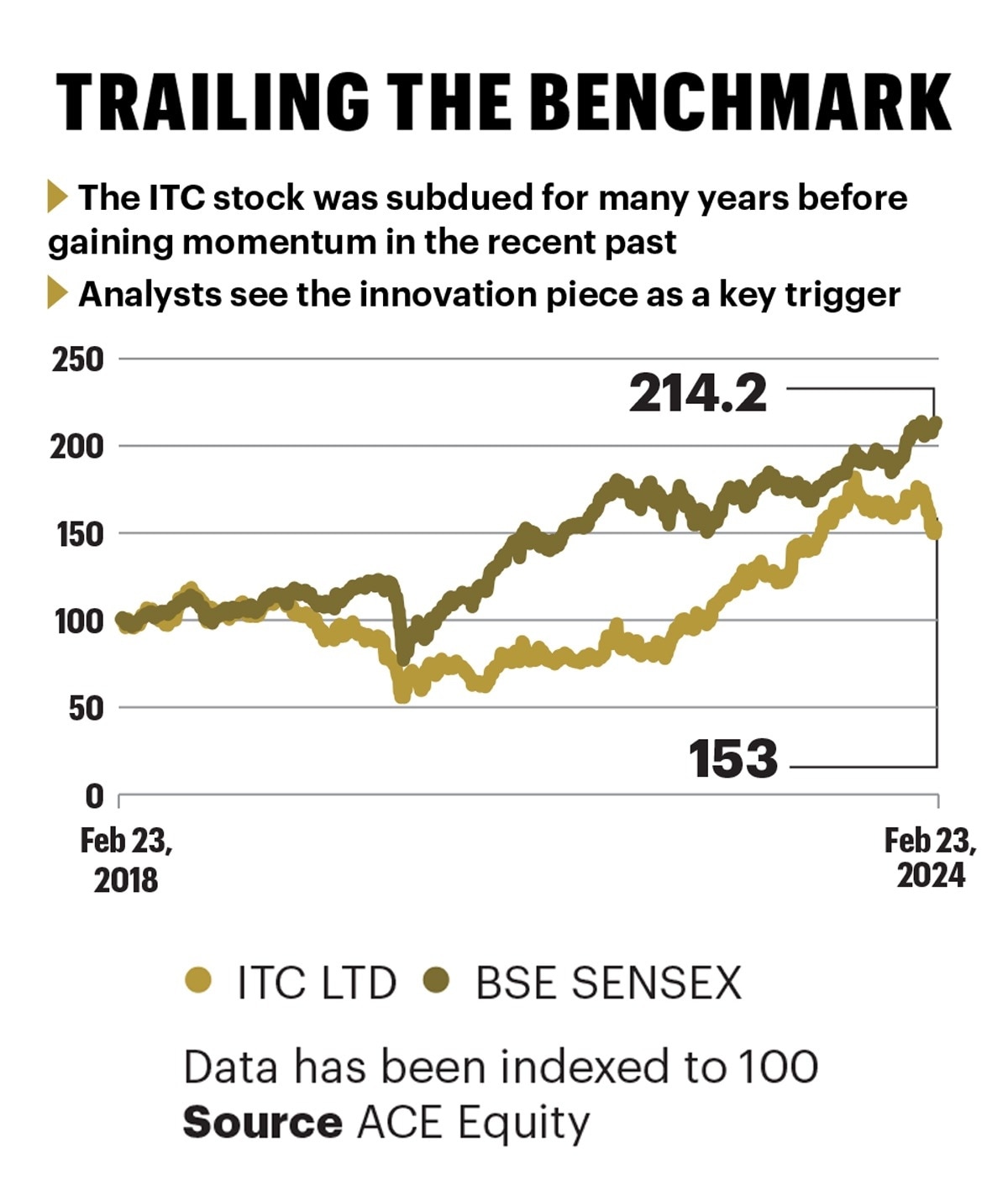
 Sanjiv Puri has broadened ITC’s reach well beyond cigarettes. The demerger of its hotels business shows the firm’s push to keep the growth engine well oiled
Sanjiv Puri has broadened ITC’s reach well beyond cigarettes. The demerger of its hotels business shows the firm’s push to keep the growth engine well oiled  Sanjiv Puri has broadened ITC’s reach well beyond cigarettes. The demerger of its hotels business shows the firm’s push to keep the growth engine well oiled
Sanjiv Puri has broadened ITC’s reach well beyond cigarettes. The demerger of its hotels business shows the firm’s push to keep the growth engine well oiled Despite a busy work schedule, Sanjiv Puri is particular about two things: he begins each day with 30 minutes of meditation and ends it with 45 minutes of yoga, regardless of where he is.
The meditation and yoga help Puri, 61, the Chairman and MD of ITC, steer the company’s diverse businesses. Since he took charge as MD in May 2018 and Chairman a year later, ITC has grown rapidly across segments, be it on revenue, profitability, or market share. The ITC stock, which the markets did not warm up to for many years, has surged over the last 24 months by 86.18%. For a company primarily associated with cigarettes, the growth in its FMCG business has placed it in the industry’s top deck. Last year, ITC announced the much-expected demerger of its Rs 2,600-crore hotel business, allowing investors to participate in another business.
Other pieces in the ITC story—agri, paperboards, paper and packaging, and information technology—are interestingly poised. The synergy between businesses often becomes a strategic differentiator. The ability to innovate and build on a robust backend is expected to write the next chapter of ITC’s growth story.
Consumer tech
One loses count of the times Puri mentions “digital” during our two-hour conversation. In his elegant room at ITC’s Virginia House headquarters in Kolkata, he says digital has to be mainstreamed. “For us, it must be as pertinent as any manager looking at his email. Everyone must be upskilled, and we already have the infrastructure,” says Puri, winner in the Large Companies category of the BT-PwC India’s Best CEOs ranking.

How is ITC taking to digital technology? Namma Chakki (any of the 12 types of grains ground to order) is one example of mass customisation. ITC buys agricultural produce through Astra, an artificial intelligence and machine learning platform that helps in smart sourcing or strengthening “our supply chain with digital”, he explains. The impact of digital is now palpable. In the all-critical sales function, ITC taps 12,000 variables. For instance, a salesman has a Generative AI app that points towards trends in his area: it could even be a country fair where the snacks portfolio can be pushed.
Not only is a lot of time saved, it is also put to better use. And the insights are invaluable. Puri says concepts can be tested online with tools such as Unnati, ITC’s B2B app, and Sixth Sense, a sensing engine. That is the first stage. “Our factories have simulation tools, and once a product is ready for launch, the question of when you do it is decided by an algorithm,” he says. That needs to be spaced out well, given the pipeline—in FY23, ITC launched 90 products and over 100 this year.
The best example was Savlon during the pandemic, he says, when people made handwashing an extreme habit. “We scaled manufacturing to move to disinfectants, and it was launched in five to six weeks,” says Puri. In winter, that opportunity came through disinfectant aerosols for clothes. “Now, the use of disinfectants and sanitisers has dropped, but it gave a lot of momentum to Savlon,” he says.
Innovation and beyond
ITC emphasises R&D, driven by its Life Sciences and Technology Centre, the innovation base. For Puri, innovation and product quality are key focus areas. A recent launch was Aashirvad Besan, and, as he puts it, while it looks like a simple product, the challenge was to avoid lump formation when water is added to form a batter. “To get the right taste, you need the right channa, and that’s where our agri backend comes in.”

Shirish Pardeshi, Co-Head (Research) at Centrum Broking, believes the “cutting-edge technology-backed innovation” has helped ITC launch 300+ differentiated products in its FMCG basket. “It has enabled them to define new vectors of growth and reflects in the success of initiatives in cream biscuits, value-added atta, milk and beverages. It will help them improve throughput in D2C channels, including modern trade and quick commerce platforms.”
Be it any business, Puri says the aspiration is to be the leader not just in financial performance but also in product quality. Sometimes there are glitches, as in cigarettes where ITC is No. 1. But it says the legal market is 8-9% of the total consumption basket. The rest comes from smuggled cigarettes. “Taxation is extreme, and consumption swings to illicit, but some stability has enabled the industry to claw back. We have strengthened the portfolio,” says Puri. Today, the non-tobacco revenue is two-thirds of the total.
On cigarettes, Abhijeet Kundu, Senior Vice-President of Research at Antique Stock Broking, says ITC’s product launches and innovation become entry barriers for competition. “ITC has been very aggressive on both. Plus, the drop in illicit consumption has helped.” It is perhaps more obvious in the case of foods, a more visible category. “Take the case of millets and it is clear they are investing for the future. The success in FMCG [the company estimates the addressable market to be Rs 5 lakh crore] has been driven by foods and we are also seeing traction in ITC’s personal products portfolio.”
A meeting with Puri is never complete without a spread of ITC’s snacks. We dig into paneer pakodas, millet cookies (something he is very kicked about) and two versions of Aashirvaad ready-to-eat halwa. To wash it down, he offers B Natural, a natural juice brand ITC bought in 2014. “We have placed a lot of emphasis on the supply chain, which led to the creation of our ICMLs,” he says, referring to ITC’s integrated consumer goods manufacturing and logistics facilities. “It was important to be close to the market, and much of this was tweaked post-Covid to bring agility.”
To him, FMCG is about choosing categories to grow in, using the penetration logic and the transformation from unbranded to branded, while ICML facilities have been built for scale.
Sustaining growth
Cut to the paperboards business, where per capita consumption in India is 14 kg against a global average of 55-60 kg. Puri speaks of looking for a new site and sustainable packaging as a significant opportunity. ITC is also growing its agribusiness, focussing on value-added products. “Agriculture is the business of tomorrow because of challenges in food security,” says Puri. From an investor point of view, the demerger of the hotel business was a big story, and he says the timing is right since it has matured. “Institutional synergy is critical here concerning brands, and much work is taking place.” There are more than 120 properties across 70 locations, totalling 11,600 room keys.
Puri admits to not being very aggressive until about five years ago when he took over as Chairman. In the FMCG business, which has seen a fair level of M&A activity, often at considerably large valuations, the biggest buyout ITC made was for Rs 2,150 crore—for Sunrise Foods, a Kolkata-based spices maker, in May 2020. “For us, the strategic fit is important with how much headroom there is for growth. We may do it inorganically but always with an eye on valuation,” he says.

One example he picks is Nimyle, a floor cleaner brand, again through an acquisition. The rationale was the world tilting towards natural and neem-based products. “If you look at Sunrise, the category has a certain resistance to change, but we can bring in value because of our sourcing and product development synergies,” points out Puri. Since the buyout, the market share has increased in West Bengal, and the brand now sells in Bihar, Jharkhand and the Northeast. The importance of being a good fit is again demonstrated in the acquisition of Yoga Bar (bought early last year), where the company saw an opportunity in “healthy, premium snacking.” The two most important boxes to tick on the M&A story for ITC are a combination of the right fit and value accretion.
Centrum Broking’s Pardeshi views the inorganic strategy from the past as cases of being able to turn around brands such as B Natural and Nimyle. “However, ITC’s recent investments in the fast-growing D2C space, such as Mylo, Yoga Bar and Mother Sparsh, indicate a balanced growth strategy. That means entering futuristic high-growth categories that bring in millennials.”

The one business that has gone almost unnoticed is ITC Infotech, largely because of its small contribution to the pie. Puri ran this at one point and is convinced of the potential. “We are in the upward quartile of the mid-tier and have started to invest more. With the disruption in tech coming from areas like digital, it is good for a small player since it is more tightly linked to business outcomes,” he says. The pandemic came in the way of hiring good talent, and the growth strategy is clear in his mind. “We must be an inch wide and a mile deep instead of a mile wide and an inch deep.” The business has done a few deals, though Puri emphasises that it will be around tuck-in acquisitions (the buyout of a smaller company) to strengthen capability. “We are a young company and size and scale should come from the depth of capability.”
Over the next three to four years, each business’s vision is to have industry-leading growth. “We must make appreciable progress towards leadership, where we are not leaders,” he says. Just in case one is thinking about how long this growth engine will continue at this pace, Puri is blunt, saying the question is only about identifying the pockets of opportunity. “It is clear that the best is yet to come for ITC.” That is some food for thought.
@TheSouravM, @krishnagopalan
Copyright©2024 Living Media India Limited. For reprint rights: Syndications Today